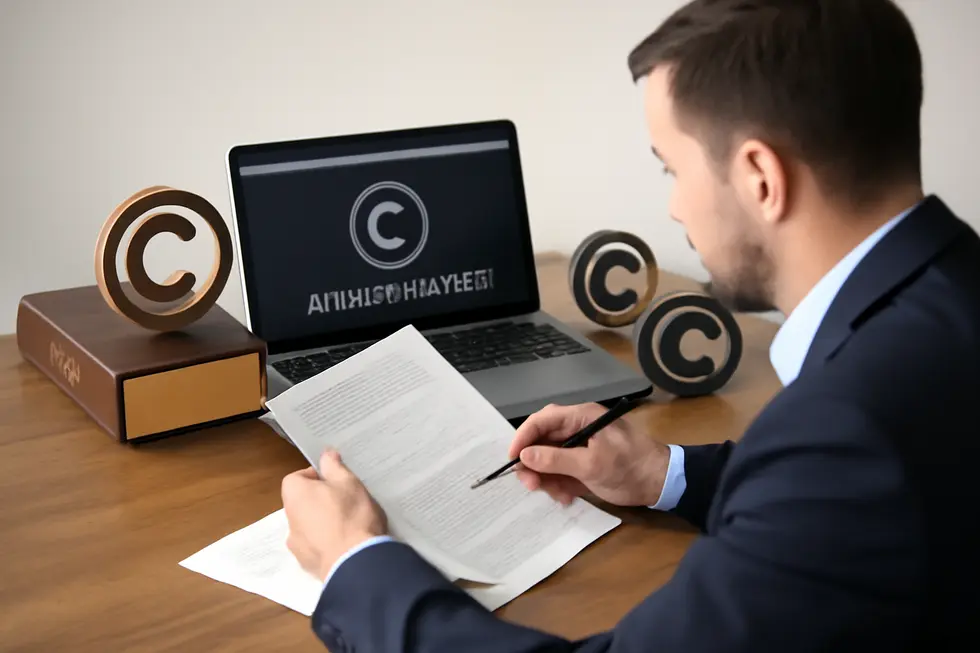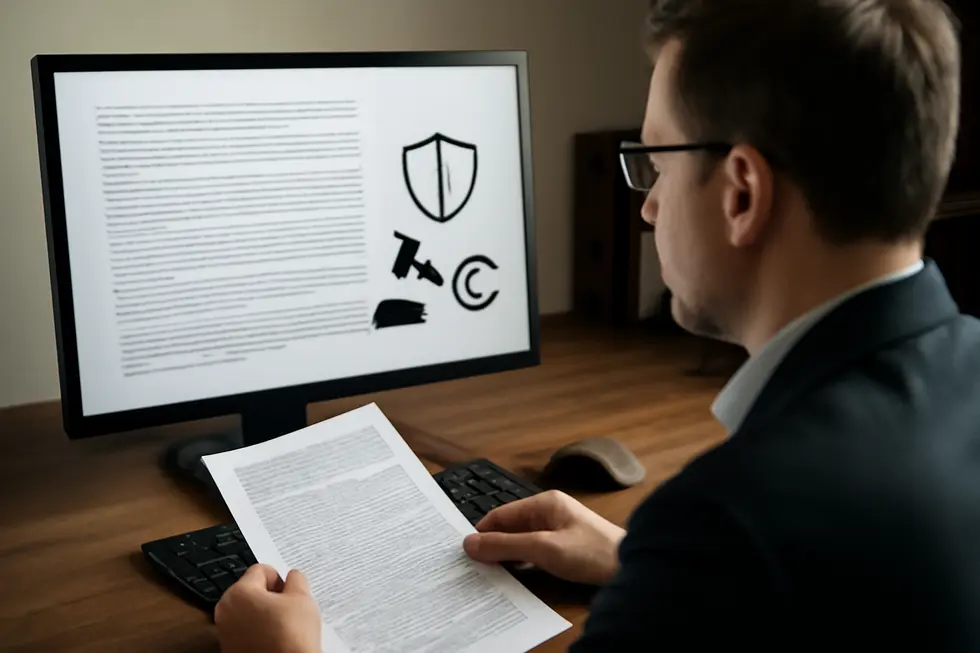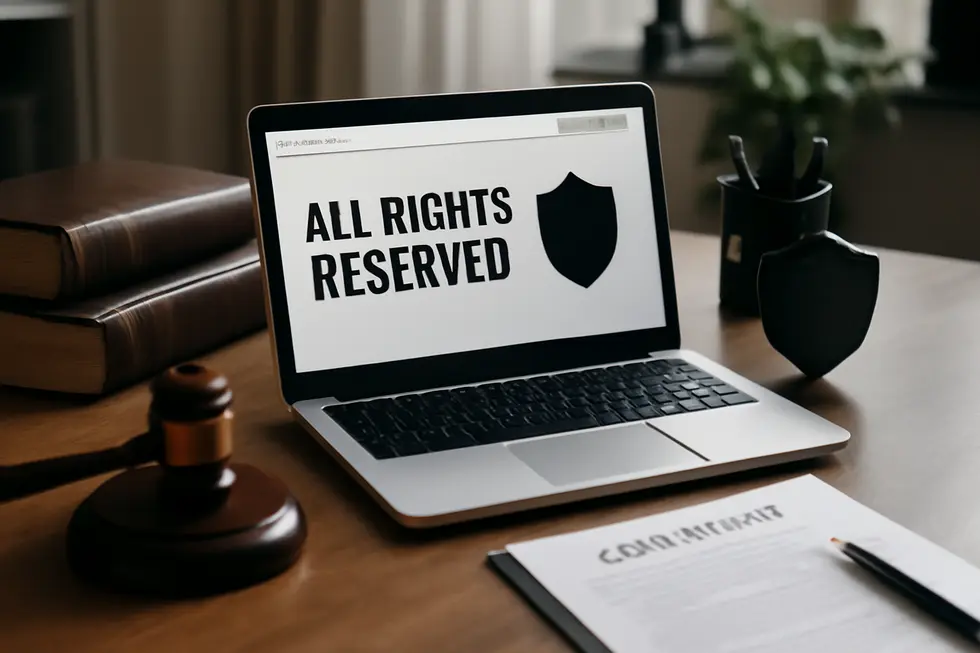Introduction
For business owners investing in digital presence, safeguarding website content is more crucial than ever. An “all rights reserved” website signals that the owner asserts complete legal control over its original materials, preventing unauthorized use. This protection is essential not only to maintain a competitive edge but also to avoid costly copyright infringement disputes. An effective understanding of copyright laws, content usage implications, and enforcement mechanisms will empower businesses to confidently manage their online assets. The following chapters deeply examine the legal foundations of all rights reserved websites, explain their impact on content usage and licensing, and outline the terms and conditions that uphold these protections in practical, enforceable ways.
Tables des matières
Chapter 1: Copyright and Legal Protections in an All Rights Reserved Website
- Harnessing Exclusive Copyright Rights and Enforcement Strategies for All Rights Reserved Websites
- Clarifying Ownership and Use: The Crucial Role of Copyright Notices and Permission Protocols
- Navigating Fair Use and Digital Enforcement in All Rights Reserved Websites
Chapter 2: Implications of All Rights Reserved Website on Content Usage and Licensing
- Navigating Legal Risks and Enforcement Challenges of All Rights Reserved Websites
- Navigating Licensing and Permissions: Essential Considerations for Using Content from All Rights Reserved Websites
- Navigating User Restrictions and Owner Protections under All Rights Reserved
Chapter 3: Terms, Conditions, and Enforcement Mechanisms in an All Rights Reserved Website
- Defining Ownership and User Rights: Key Legal Terms in All Rights Reserved Websites
- Controlling Access and Content Integrity: Modification, Monitoring, and Restrictions in All Rights Reserved Websites
- Ensuring Legal Protection: Cooperation, Liability Limits, and Binding Agreements in All Rights Reserved Website Terms
Chapter 1: Copyright and Legal Protections in an All Rights Reserved Website

1. Harnessing Exclusive Copyright Rights and Enforcement Strategies for All Rights Reserved Websites
An “All Rights Reserved” website firmly asserts the full spectrum of copyright ownership, granting the owner exclusive rights to reproduce, distribute, publicly display, and create derivative works from the content. These rights arise automatically upon creation but are fortified by formal registration, easing pursuit of legal action and awarding statutory damages when infringements occur. Unauthorized copying, sharing, or modification of the site’s content without explicit permission constitutes clear copyright infringement.
To enforce these rights, website owners employ a combination of legal and technological measures. Legal actions often commence with cease-and-desist communications and may escalate to lawsuits claiming damages. On a technological front, automated digital tools such as content identification systems detect unauthorized use and facilitate prompt removal or monetization of infringing material. Additionally, the DMCA takedown process empowers copyright holders to request removal of infringing content on hosting platforms, supplemented by counter-notification procedures to address disputes fairly.
Institutions managing such websites often complement these efforts with policy-based disciplinary actions to deter unauthorized distribution. Internationally, protection persists under treaties like the Berne Convention, although enforcement complexity varies by jurisdiction. Ultimately, those managing an All Rights Reserved website depend on a robust framework of exclusive rights, supported by both statutory and technical enforcement mechanisms, to safeguard their intellectual property and commercial interests.
For a deeper understanding of copyright enforcement strategies, refer to DMCA takedown procedures.
2. Clarifying Ownership and Use: The Crucial Role of Copyright Notices and Permission Protocols
Copyright notices serve as a vital tool on an “All Rights Reserved” website to clearly communicate ownership and legal protection. Typically composed of the © symbol, the year of first publication, and the copyright holder’s name, this notice is not mandatory for protection but strongly advised. It publicly asserts that the content is protected, identifies who owns it, and dates the work’s origin—key factors if legal disputes arise. By prominently displaying this notice, website owners deter infringement by signaling that reuse without authorization is prohibited.
Beyond notices, explicit permission requirements form the backbone of protecting content. Visitors intending to use site materials beyond fair use exceptions must seek direct approval from the copyright owner. This authorization process usually involves contacting the owner through details provided alongside the copyright information. Unauthorized use without such consent can lead to legal consequences, reinforcing the site owner’s control over distribution and reproduction.
Together, copyright notices and permission protocols establish a clear framework that affirms ownership and regulates content use. They empower website owners to uphold their exclusive rights and inform users of their legal obligations. For guidance on drafting effective copyright statements and navigating permission requests, resources such as the U.S. Copyright Office Circulars offer valuable insights.
For further understanding of copyright enforcement and how these measures integrate with a site’s legal posture, consulting expert advice on copyright legal costs and protections can help ensure comprehensive safeguards.
3. Navigating Fair Use and Digital Enforcement in All Rights Reserved Websites
Fair use serves as a vital legal exception within the robust protections of an All Rights Reserved website. While the website owner claims exclusive rights over all original content, fair use allows limited unlicensed use under specific conditions such as commentary, criticism, education, or research. Determining fair use involves analyzing four key factors: the purpose and character of use, how transformative it is, the nature of the copyrighted work, the amount used, and the potential impact on the market value of the original content. This nuanced, case-by-case assessment often challenges website owners and users alike.
To enforce copyrights digitally, owners employ tools like digital rights management (DRM), automated monitoring, and DMCA takedown notices. These mechanisms safeguard their content from unauthorized copying and distribution. Yet, enforcement efforts must respect fair use boundaries, ensuring that legitimate uses for criticism or scholarship are not wrongfully suppressed.
Balancing these interests protects creators’ rights while maintaining public access to information and expression. Website owners should explicitly communicate copyright terms but also recognize fair use as a legal defense rather than an absolute right. For guidance on navigating these complexities, consult resources like the Antares Systems guide on copyright and fair use.
Additionally, understanding copyright enforcement in this digital landscape complements broader protections discussed in chapters like the role of copyright notices and permission requirements. For related insights on managing intellectual property online, explore the comprehensive overview of the six exclusive rights of copyright.
Chapter 2: Implications of All Rights Reserved Website on Content Usage and Licensing

1. Navigating Legal Risks and Enforcement Challenges of All Rights Reserved Websites
An “All Rights Reserved” designation on a website establishes the owner’s exclusive control over all site content, encompassing reproduction, distribution, public display, and derivative works creation. Unauthorized use without explicit permission constitutes copyright infringement, exposing offenders to legal consequences such as takedown notices, cease-and-desist letters, and potentially costly litigation. Enforcement commonly relies on the Digital Millennium Copyright Act (DMCA), which empowers copyright holders to demand removal of infringing content from internet platforms. Compliance with DMCA takedown procedures is crucial for both copyright owners and hosting services to mitigate liability risks.
Users aiming to incorporate content from an “All Rights Reserved” site must secure proper licensing or permission clearly defining usage scope. Failure to do so leaves them vulnerable to infringement claims. While some websites may assert overly broad rights or issue aggressive takedown demands, courts and platforms often assess these claims stringently, especially when fair use exceptions might apply. To minimize legal exposure, website owners should explicitly detail copyright terms and licensing policies, while users must verify content status before use.
For a deeper understanding of copyright protections and DMCA compliance strategies, refer to LegalZoom’s detailed explanation on copyright rights and enforcement.
2. Navigating Licensing and Permissions: Essential Considerations for Using Content from All Rights Reserved Websites
All Rights Reserved on a website signals that the copyright owner holds exclusive control over every aspect of the site’s content. This means users have no automatic permission to reuse, reproduce, distribute, or alter the material without explicit authorization. To legally use such content, a formal licensing agreement directly from the copyright holder is necessary. These licenses carefully outline the specific rights granted, including permitted usage channels, duration, and any payment requirements. Unlike free or open licenses, which allow certain uses under predefined conditions, all rights reserved content mandates clear, intentional permission for each use case.
Securing a license involves identifying the rights owner and negotiating terms that respect the author’s moral and economic rights, which remain intact regardless of the license. These agreements prevent unauthorized exploitation and often prohibit creating derivative works without consent. Failing to obtain proper permissions exposes users to legal risks such as infringement claims, fines, and content removal. Conversely, website owners aiming to maintain control over their intellectual property reinforce their claims with visible copyright notices and may offer tailored licenses to clarify permitted uses.
For creators seeking more detailed guidance on copyright licensing, resources like the Wikimedia Commons Licensing Overview provide valuable information on structuring rights and permissions. This careful approach to licensing not only protects original content but also fosters respectful and lawful use across digital platforms.
More legal insights on protecting intellectual property and licensing nuances can be found in articles such as 10 Facts About Copyright.
3. Navigating User Restrictions and Owner Protections under All Rights Reserved
An “All Rights Reserved” website creates a clear legal boundary defining how its content can be used by others. For users, this restriction means they cannot copy, distribute, or modify any material without explicit permission from the content owner, except in narrowly defined cases such as fair use for commentary or education. Unauthorized use risks legal consequences, including takedown notices or lawsuits. Consequently, users must seek licenses or permissions before reusing content, which adds a layer of caution and complexity to engaging with protected works.
For content owners, “All Rights Reserved” consolidates exclusive rights to reproduce, display, distribute, and create derivative works based on their original content. This allows owners maximum control over their intellectual property and empowers them to enforce their rights effectively through legal channels like DMCA takedown requests and litigation. While copyright protection exists automatically, formal registration strengthens enforcement by providing documented evidence of ownership and eligibility for statutory damages.
Thus, this designation sharply limits user freedoms while offering content creators robust legal safeguards to protect the economic value and integrity of their work. The balance ensures creators retain full authority over their original content while users must carefully navigate usage and licensing protocols. For a deeper insight into copyright protections, see this overview of the 6 exclusive rights of copyright.
Chapter 3: Terms, Conditions, and Enforcement Mechanisms in an All Rights Reserved Website

1. Defining Ownership and User Rights: Key Legal Terms in All Rights Reserved Websites
An All Rights Reserved website firmly establishes the website owner’s exclusive ownership and copyright over every piece of original content, including text, images, videos, software, and trademarks. Users are granted a narrow, revocable license that allows limited, personal, and non-commercial use of the site’s materials without transferring any ownership rights. This license is explicitly non-transferable and restricts users from copying, distributing, modifying, or creating derivative works without prior authorization.
The legal framework underpinning this arrangement requires users to comply strictly with the website’s terms and applicable copyright laws, reinforcing the limited scope of permitted use. In cases where users contribute content, the website typically secures a broad, royalty-free license to display, modify, and distribute that material globally, ensuring uninterrupted service operation while retaining full intellectual property rights.
Enforcement provisions empower the website owner to suspend user access or remove infringing content immediately upon violations. Users warrant that any submitted content does not breach third-party rights and accept that the website may delete content that violates these terms. Additionally, clear dispute resolution clauses and governing law specifications bolster enforcement, enabling legal action against unauthorized use or breaches.
This comprehensive user agreement structure preserves the site owner’s full control over intellectual property while enabling controlled user interaction. For further insight into the legal nuances of copyright protections in digital environments, review this helpful resource on the 6 exclusive rights of copyright.
2. Controlling Access and Content Integrity: Modification, Monitoring, and Restrictions in All Rights Reserved Websites
An “All Rights Reserved” website employs comprehensive terms and conditions that tightly regulate how users interact with its content. Integral to these controls are modification restrictions that forbid copying, altering, or creating derivative works from the website’s original materials without explicit permission, preserving the content’s integrity under copyright laws. Alongside these are robust monitoring rights, whereby the website owner continuously oversees user behavior and uploaded content to detect violations and protect intellectual property. This monitoring safeguards the site’s service quality and legal compliance, though owners typically disclaim liability if prohibited content is not immediately removed.
Access restrictions further empower owners to suspend or terminate user privileges when terms are breached or unlawful activity is suspected. These enforcement actions may include cooperating with law enforcement or disclosing user information to uphold legal protections. Users often receive a limited, revocable license solely for personal, non-commercial use, with any user-submitted content granting the owner broad rights to utilize it for site operations. Such terms also mandate compliance with applicable laws and prohibit harmful acts like reverse engineering or unauthorized distribution. Collectively, these mechanisms form a structured framework that protects the website’s creative output while defining strict boundaries on user conduct, effectively balancing control and lawful use.
For a deeper understanding of enforcing intellectual property rights within these frameworks, exploring legal costs and safeguards associated with copyright protection can provide valuable insights.
3. Ensuring Legal Protection: Cooperation, Liability Limits, and Binding Agreements in All Rights Reserved Website Terms
Legal Cooperation and User Responsibility in an all rights reserved website’s terms compel users to aid the site owner in defending legal claims tied to their usage. This cooperation often includes indemnifying the owner for any damages or costs arising from violations such as intellectual property infringement or breaches of terms. The website owner typically retains control over legal defense and settlement decisions, preventing users from independently resolving claims.
Liability limitations are crucial, as terms frequently cap the owner’s financial responsibility for damages incurred by users. These caps are often linked to specific amounts or the fees paid by users, excluding indirect or consequential losses like lost profits, to mitigate risk. Such provisions help maintain a sustainable framework for content protection while complying with legal restrictions in various jurisdictions.
An entire agreement clause serves to consolidate all understandings between the user and website owner into a single binding document, effectively overriding any prior discussions or promises outside these terms. This solidifies the terms as the definitive rules of engagement, ensuring clarity and enforceability.
Together, these provisions create a robust legal infrastructure, reinforcing copyright protections and supporting enforcement actions, including collaboration with authorities when necessary. For further insight on handling infringement claims, consult these legal remedies.
Dernières réflexions
An “all rights reserved” designation is more than just a statement on a website; it is a strategic legal assertion critical for business owners to protect their digital assets. This protection begins with understanding copyright law’s foundational role, leveraging exclusive rights to control content use, and implementing clear terms and enforcement measures. By doing so, businesses safeguard their original work, preserve brand integrity, and maintain a competitive edge in the digital marketplace. The investments made in content creation and innovation deserve this full spectrum of protection to thrive securely online.
Obtenez votre marque dès aujourd'hui ! Des milliers de personnes ont protégé leur marque en déposant une marque. Qu'attendez-vous ? Commencez à déposer votre marque !
A propos de nous
The globe’s top website for registering trademarks and safeguarding your brand, name, logo, or slogan. We provide trusted, easy-to-use services that empower businesses to protect their intellectual property rights efficiently and effectively.







